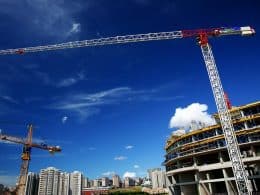Concrete is tough, durable and can last a long time but it absorbs oil, fluids, chemicals and bacteria. These substances also damage equipment, tools and vehicles.
Bare concrete fosters mold, mildew and other microbial life and requires frequent sweeping to maintain cleanliness. A well-finished garage adds value to your home and is a big selling point for potential buyers.
1. Durability
Concrete is the backbone of many buildings, including houses and schools as well as airports, highways and railway systems. Its durability, strength and relative low cost make it the most-produced material on Earth. It will only become more in demand as urbanization increases and extreme weather events necessitate more durable building materials.
While many people focus on waterproofing their basements, a garage floor should be just as protected. Moisture is just as damaging to a concrete slab as it is to the rest of a house, and can lead to cracking and discoloration of your valuable possessions and tools. Waterproofing a garage floor is relatively simple and inexpensive, when done properly.
The most popular form of concrete is poured in place, but precast concrete slabs are also available. These slabs are manufactured at factories to specific thicknesses and sizes, and can be installed in a fraction of the time it takes to build a house from scratch. They are also much more affordable than a custom-built home.
When it comes to durability, concrete beats other building materials hands-down. It can withstand high heat, which is especially important in areas with a significant wildfire risk. It also has a lower moisture content than wood, and does not rot or rust like steel. It is fire resistant and requires less maintenance after construction, which can save on long-term costs.
One of the most common mistakes is to use a regular floor paint in a garage, but concrete-specific coatings are available that will provide superior performance for your space. A good choice is a polymer-based product that provides a thick and strong coating for your concrete, and can be applied as easily as ordinary paint.
2. Aesthetics
Concrete has long been a popular construction material, but it’s not merely utilitarian. It can be used in garages to create a stylish space that’s durable, affordable and low-maintenance. There are a number of different ways to make concrete more attractive, including polishing it to give it a shiny, reflective finish and staining it in various colors. You can also use concrete to make home accents, such as a concrete fireplace surround or concrete planters.
Many people don’t consider how the floors of their garages look, but if they want to use the space as more than just storage for vehicles and tools, they need something that will hold up to heavy equipment and traffic. Tile can be a good option, but it isn’t durable enough for the garage. Concrete, on the other hand, can be sanded, polished and sealed to achieve a refined aesthetic. In addition, it’s less expensive than installing a new floor.
The key to making a concrete floor in the garage last is choosing the right mix and coating. Depending on your climate and external conditions, you may need a mix that will resist freezing and thawing. Using a concrete sealer that is UV stable can also help to protect the surface and keep it looking great for years to come.
Aside from protecting cars from the elements, garages are often used as a workshop or studio. With a little creativity, the space can be transformed into a living area that can add to the value of the home. Getting a quality concrete garage floor that has been sealed can ensure the space is ready for anything and will look good at any time of year.
3. Stain Resistance
Stains are a cosmetic problem that can mar concrete surfaces and leave your home with a bad look. Whether it is oil stains in the garage floor, wine or coffee stains on countertops or red wine staining outdoor concrete surfaces, it is important to protect your investment with a stain resistant sealer. These are for kitchens, bathrooms, and other areas where sanitation is essential.
Unlike paint, concrete stains do not flake and can last much longer than the life of a typical acrylic coating. When properly protected, your stained concrete will hold up well to the elements, foot traffic and even chemical spills.
A stain resistant concrete sealer will also help prevent the damage caused by deicing salts and freeze-thaw cycles, which can cause concrete to crack and chip. It will also protect the surface from water-borne contaminates such as dirt, dust and other airborne pollutants.
There are many coloring options besides staining that can be used on new and existing concrete. Integral color, color hardeners and various overlays can reproduce patterned and mottled effects to some extent, but they will not produce the depth of color that is possible with a good stain.
A quality stain resistive concrete sealer can be used on top of a concrete overlay or patching system to unify the appearance of repairs, job continuations and partial slab replacements. This product can also be used to renew the color intensity and uniformity of weathered or aged concrete. Unlike many other concrete stains, this solvent-based product does not contain VOCs (volatile organic compounds) that may cause headaches and dizziness when inhaled. It is safe to use in homes and buildings with occupied spaces and can be applied to damp concrete surfaces. It is also easy to apply and dries completely clear. A plastic anti-slip additive can be mixed into the final coat of sealer to improve traction on wet concrete without affecting the color.
4. Easy Maintenance

Concrete is used in many areas of a home because it is easy to care for. A concrete floor in a garage is no exception. It is possible to clean it by mopping occasionally with soapy water. It can also be stained, polished or stamped to achieve a unique look for a floor, walkway, patio or driveway that can improve the appearance of a property while providing a durable surface.
Despite its durability, concrete does have some drawbacks in the garage. Grease and oil spills can discolor the concrete, and they can also cause damage to the slab if left unattended over time. This can lead to cracking of the concrete, and this can affect the overall strength and longevity of the garage.
Another drawback to concrete is that it is hard underfoot, which can be uncomfortable for family members and guests who spend a lot of time in the garage. Area rugs can help alleviate this problem. Fires are a concern, too. Concrete is resistant to heat and flames, which can save lives and minimize property loss.
Adding a floor covering like epoxy can provide a layer of protection to the concrete in the garage, and it can also make the floor easier to maintain. Before you can coat your concrete, however, it is important to make sure the garage is empty and free of dirt, grease, oil and other debris. It is also a good idea to remove any furniture or storage shelves that touch the floor, and it may be necessary to grind the surface of the concrete or apply an acid etching solution. Once the garage is clear and ready to be coated, follow the instructions for application of a product such as DRYLOK’s E1 Latex 1-Part Epoxy Concrete Floor Paint. For added traction, you can add up to 2 ounces of DRYLOK Non-Skid Texture Additive to the epoxy.
5. Eco-Friendly
Concrete is the backbone of modern society – it’s in our buildings, bridges, sidewalks and roads, yet we rarely think about how it’s made or what it can do for us. Unlike wood that can rot or be easily destroyed by natural disasters, concrete is an incredibly durable building material that requires little maintenance. And now, eco-friendly concrete is making it even better for the planet.
Sustainable concrete uses a variety of recycled aggregates to minimize energy consumption and waste. These recycled materials can also be used to reduce the amount of cement required for a given mix design, resulting in cost savings. In addition, sustainable concrete can use admixtures that reduce the water content of the mix without compromising its workability. This results in significant energy savings.
The green concrete trend is gaining momentum as more people look for ways to be environmentally responsible. In fact, concrete is one of the most environmentally friendly construction materials available. It requires very little maintenance and can stand up to the harshest weather conditions, ferocious fires and more.
Moreover, it’s a very durable and affordable building material that can be used to build long-lasting structures like parking garages. For instance, a parking garage constructed with concrete can withstand decades of heavy vehicle traffic and weather exposure. Concrete is also very easy to clean – all it needs is an occasional sweep with a push broom. This is particularly important during the winter when de-icing salt is thrown on the concrete surface, which can wear it down over time.
While many contractors still rely on traditional concrete, manufacturers are continuing to develop more eco-friendly alternatives to traditional concrete. For example, a British company called Novacem has developed a concrete that can absorb carbon dioxide. It is created using composite materials and foam beads, and it is capable of absorbing up to 0.6 tons of CO2. This is significantly more than the amount of CO2 released during the production of traditional concrete.









